Otavi Mountain Land, Namibia
Otavi Mountain Land Vanadium & Copper-Lead-Zinc-Silver Projects, Namibia
The Company’s has a series of brown-fields poly-metallic Vanadium & Copper-Lead-Zinc-Silver projects in the world-class Otavi Mountain Land (OML) copper-lead-zinc province of northern Namibia (see location, Figure 1).
The OML is a metallogenic province within the carbonate platform of the Neoproterozoic Damara mobile belt in north Namibia. The OML hosts approximately 600 mineral occurrences and prominent historically mined deposits including the major Tsumeb and the Kombat copper-lead-zinc-silver mines, with past production of:
- Tsumeb: 30 Mt @ 10% Pb, 4.3% Cu, 3.5% Zn & 100 g/t Ag (Mined)
- Kombat: 8.7 Mt @ 3.1% Cu, 1.1% Pb & 26 g/t Ag (Mined)
The mined deposits can be categorised into two distinct deposit types:
- Primary sulphide deposits of the Tsumeb& Kombat Cu-Pb-Zn-Ag type and/or the Berg Aukus Pb-Zn-Ag type – associated with sulphide mineralisation in carbonate rocks, and,
- Secondary supergene vanadium with zinc, lead and copper in vanadate oxide minerals (descloisite and/or mottramite) deposits, generally located above primary sulphide deposits.
The Company’s exploration and development programs are focused on the Abenab high-grade vanadium-zinc-lead resource; the Nosib high-grade vanadium-copper-lead-silver discovery and the Khusib Springs high-grade copper-silver deposit (Figure 1).
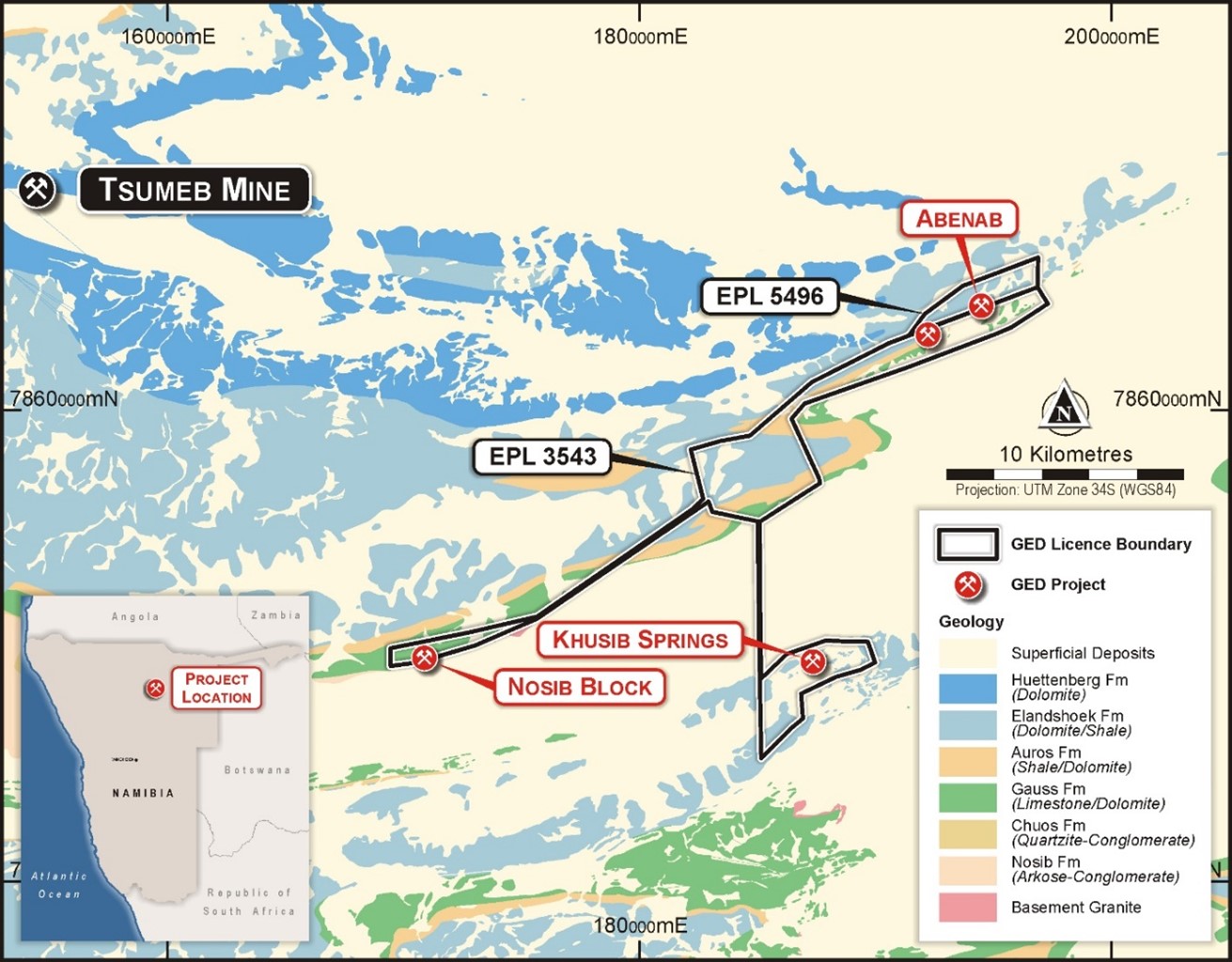
Abenab Vanadium-Lead-Zinc Project
The Abenab Project is located at the northeastern end of the Company’s EPL3543 (Figure 1) and was operated as an open pit and underground mine from 1921 to 1947 by the South West Africa Company. Historical production from Abenab included 176kt of 16% V2O5, 13% Zn and 54% Pb in high-grade concentrate.
The Abenab mineralisation is hosted by carbonates of the Otavi Group and consists of a pipelike karst breccia of collapsed country rocks cemented by coarse calcite and descloizite-vanadinite concretions. The Abenab Breccia Pipe lies on a steeply dipping sheared contact between massive dolomite and platy limestone (see Figure 2, below).
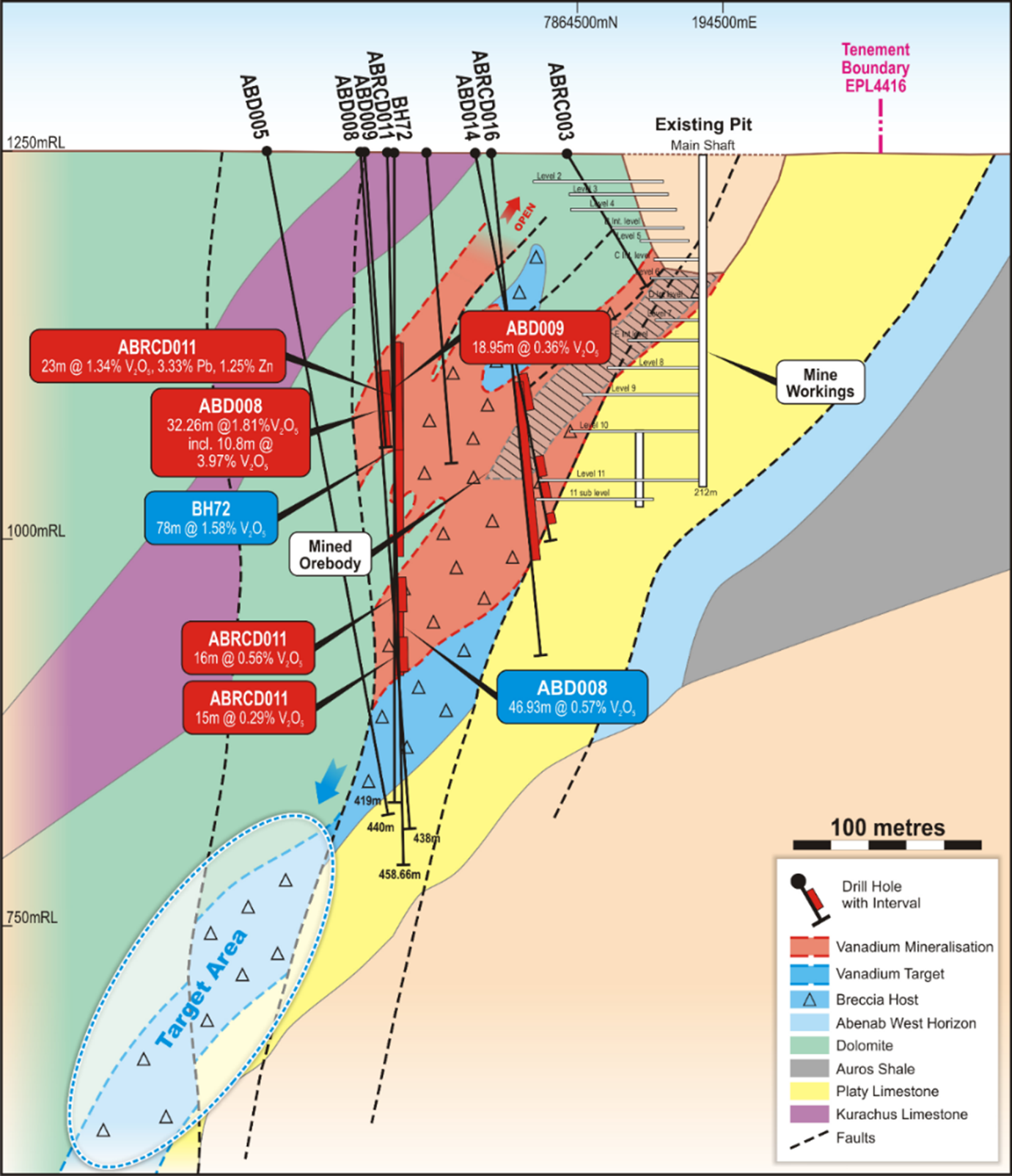
The vanadium mineralisation at Abenab is contained in the minerals descloizite (vanadium-lead-zinc hydroxide) and vanadinite (vanadium-lead chlorovanadate). The vanadium mineralisation takes several forms including breccia clast infill, fine grained fracture fill, open space crystal growth (see Photo 1 below) and clay-filled cavities.
Golden Deeps is accelerating development of the Abenab Vanadium-Lead-Zinc Project, of which it holds an 80% interest and is on track to enter production in 2020.
Metallurgical Testwork:
Metallurgical testwork on the Abenab mineralisation has focused on gravity concentration testwork to concentrate the high-density mineral descloisite. Several phase of testwork have been carried out, culminating in June 2023 with the generation of an exceptionally high-grade vanadium with zinc, lead and copper concentrate bulk-sample grading:
- 15.6% V2O5, 11.2% Zn, 38.2% Pb and 0.8% Cu
This represents an 18 times (x) upgrade of the representative drill-core composite sample, that had an assay head grade of 0.9% V2O5, 2.1% Pb and 0.7% Zn.
The Company has also carried out down-stream hydrometallurgical leach testwork which demonstrated vanadium extraction rates of up to 95% and high extraction of lead, zinc and copper from a lower grade concentrate feed generated from surface stockpiles and tailings.
Mineral Resource Estimate and Development Studies:
The outcomes of both the gravity concentrate testwork and the downstream hydrometallurgical testwork provided processing cost inputs (capital and operating) which were integrated into a new resource model for the Abenab deposit and an upgraded mining study (by Bara Consulting), to produce a scoping study for staged mining, gravity concentration and downstream processing of the high-grade Abenab high-grade V-Zn-Pb resource.
The new Mineral Resource estimate for the Abenab vanadium-lead-zinc deposit (announced 24 June 2024) was prepared by Shango Solutions of South Africa (Shango) and is summarised in Table 1 below:

Shango also prepared the previous, January 2019, Mineral Resource estimate of 2.8Mt at 0.66% V2O5, 2.35% Pb and 0.94% Zn (0.2% V2O5 cut-off), which utilised historical drilling by Avonlea Minerals Ltd.
The new Mineral Resource estimate follows further drilling by GED in 2019 which included 18 RC and diamond drillholes for 3,266m which was designed to infill and extend definition of the Inferred Mineral Resource areas identified in the 2019 model. During late 2022 to early 2023 Shango updated the Abenab model in Datamine (all previous models were created in Leapfrog Geo) incorporating the 2019 drilling results for the purposes of refining and optimising the wireframes and block models (see 3-d models, Figure 4, below). In addition, Shango included vertical (normal?) faults, as observed by Shango in the pit wall, which are interpreted to have controlled the secondary vanadium-lead-zinc mineralisation.
Mining studies by Bara Consulting of South Africa and metallurgical gravity concentration and hydrometallurgical leaching testwork provided economic parameters to determine cut-off grade parameters for the reasonable prospects of economic extraction determination.
Underground mining studies on the Abenab Mineral Resources and an open pit mining study on the Nosib Mineral Resource, in progress, are being integrated with the metallurgical/processing studies, to produce a development study (the Study) for the production of high-grade vanadium-copper-lead-zinc-silver concentrate. The Company’s testwork has shown that the concentrate can be downstream processed by acid leaching to produce high-value vanadium products such as vanadium electrolyte for vanadium redox flow batteries (VRFBs) as well as copper, lead, zinc and silver by-products.
Nosib Project
Nosib Vanadium and Copper-Lead-Zinc-Silver Deposit
The Nosib prospect is located at the western end of the Company’s EPL3543 (Figure 1), 20km southwest of Abenab. Nosib is a new discovery that has produced a number of exceptional, thick and high-grade, vanadium-copper-lead-silver RC and diamond drilling intersections over the last 12 months.
The Nosib mineralisation is hosted by an arenaceous to conglomeratic unit which is poorly exposed and lies at the base of the Damara sedimentary sequence, overlain by the dolomitic units that host the majority of the base metal mineralisation in the OML.
Drilling has identified and defined two distinct zones of mineralisation at Nosib (Figure 3):
- A shallow, high-grade, vanadium-copper-lead-silver supergene enriched zone that has produced a series of high-grade intersections of copper, vanadium and lead with silver including:
- 53.52m @ 1.15% Cu, 0.62% V2O5, 3.49% Pb, 4.57 g/t Ag from surface in NSBDD008 incl. 11.74m @ 2.67% Cu, 1.42% V2O5, 9.21% Pb, 7.12 g/t Ag.
- 45.70m @ 1.0% Cu, 0.72% V2O5, 2.8% Pb, 4.00 g/t Ag from surface in NSBDD002 incl. 12.10m @ 3.2% Cu, 2.54% V2O5, 9.8% Pb, 8.0 g/t Ag, and,
2. A thick, stratabound, copper-silver sulphide zone at depth that has produced significant true-width intersections of sulphide mineralisation up to 45m thick, across the entire thickness of the northerly dipping arenite/conglomerate host unit, including in NSBDD003:
- 44.54m @ 0.38% Cu, 3.6 g/t Ag from 62.3m incl. 11.10m @ 0.70% Cu, 5.6 g/t Ag
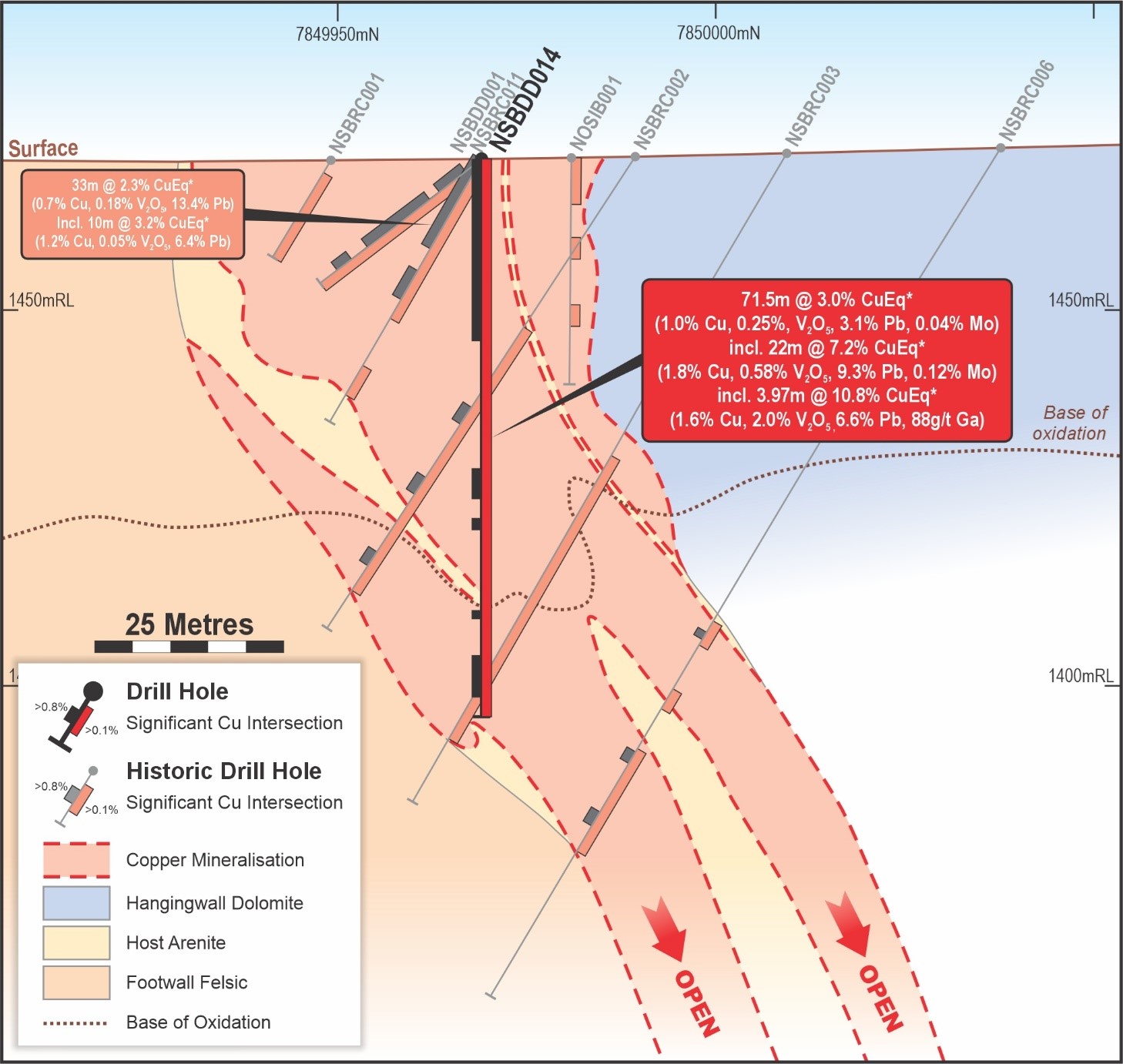
More recent drilling (2023) on step-out sections to the west of the previously drilled deposit extended the copper-silver stratabound sulphide deposit to the west and at depth. The most westerly intersection in the recent diamond drilling program intersected 44.22m @ 0.6% CuEq* (0.50% Cu, 3.2 g/t Ag) from 34.8m in NBSDD007 and included a massive sulphide zone of 0.49m @ 10.3% Cu, 56.9 g/t Ag (Figure 4 & 5). Further drilling is planned to extend this zone, to target a substantial stratabound Cu-Ag sulphide resource.
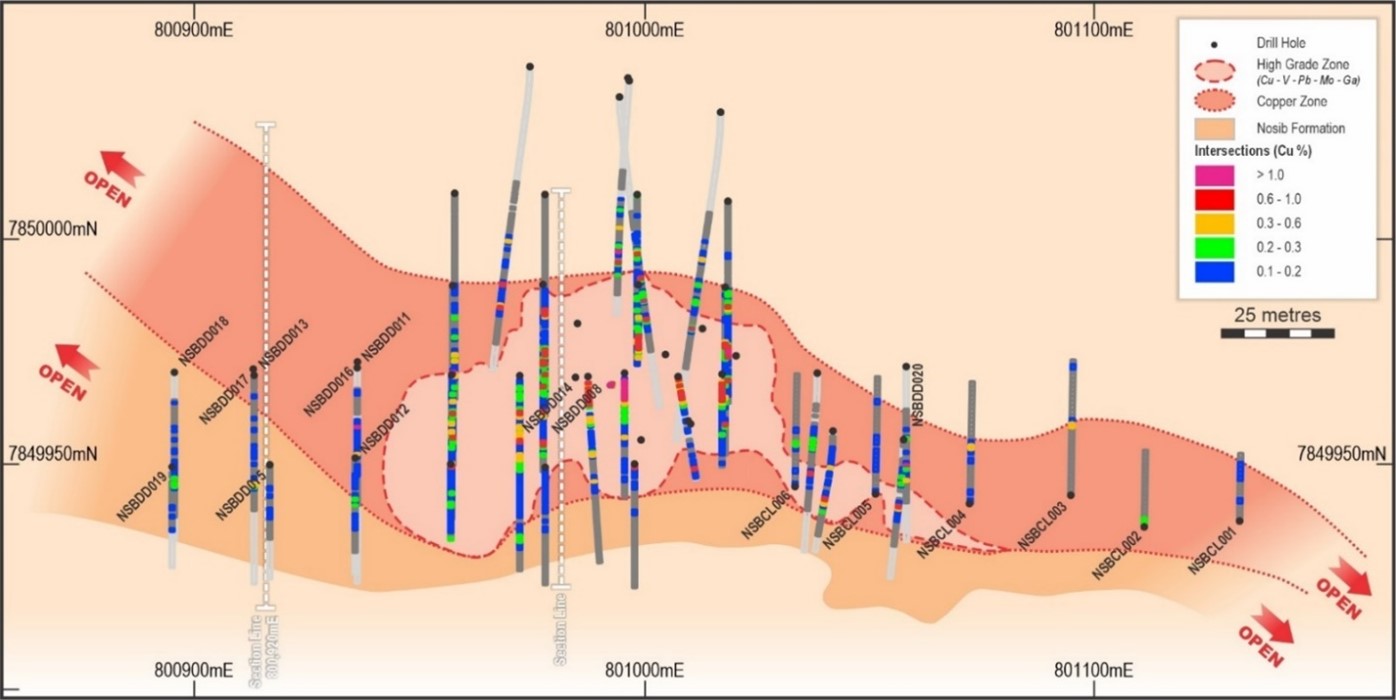
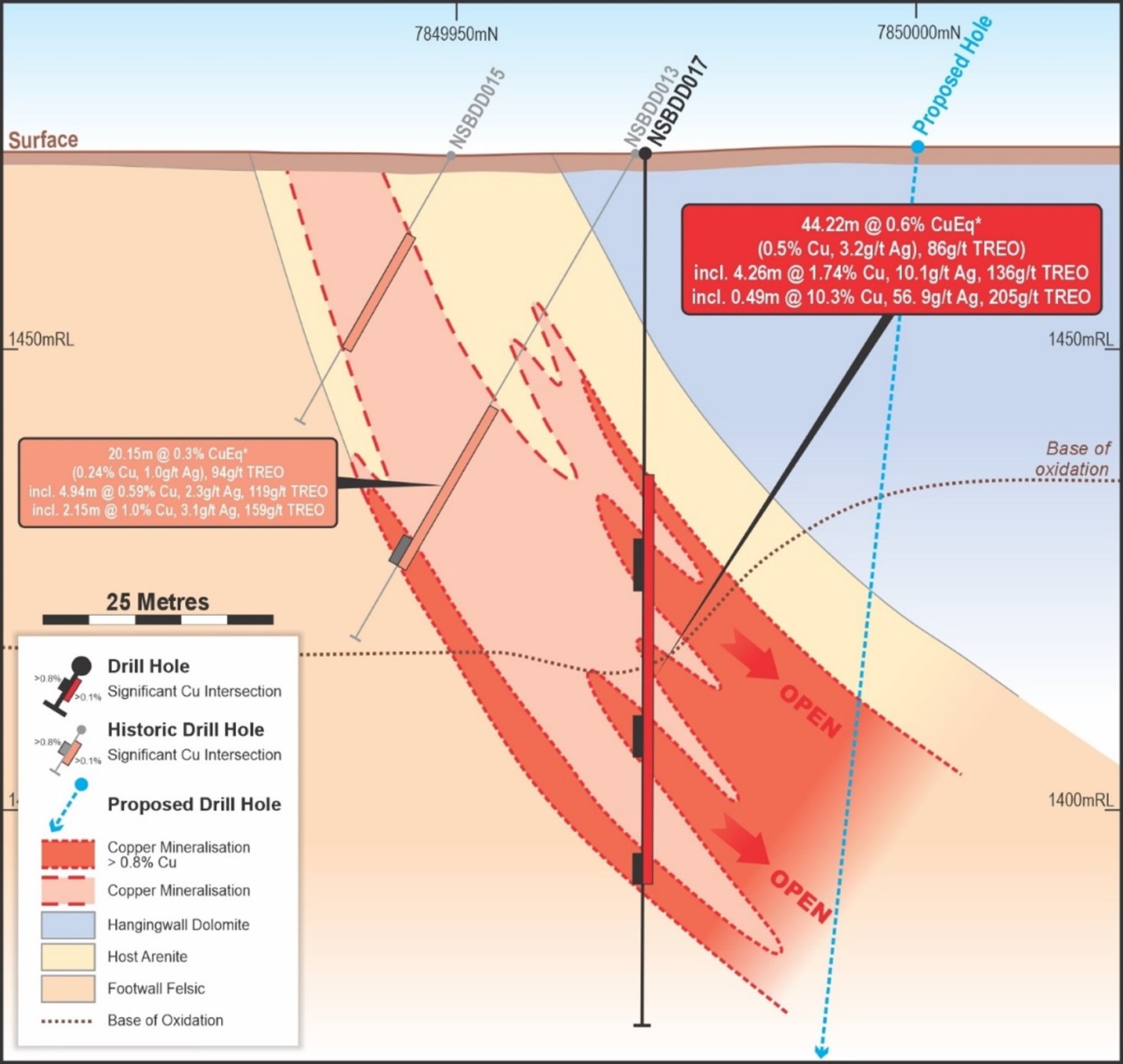
Nosib Resource, Mineral Resource Estimate and Development Studies:
Mineral Resource modelling and estimation has been carried out by Shango Solutions. The Nosib mineralisation includes a supergene vanadium-copper-lead-silver zone which has been drill defined at 10m to 20m spacing with RC and diamond drilling over a 100m strike length and to approximately 80m vertical depth (Figures 4 & 5).
The supergene mineralisation at Nosib includes the secondary vanadium minerals descloisite and mottramite. Descloisite is the same lead-zinc-vanadium hydroxide mineral that occurs at Abenab and Mottramite is a copper-lead vanadium hydroxide. Metallurgical testwork shows that these minerals respond very well to gravity concentration. Metallurgical gravity concentrate testwork on two bulk samples (drill core and surface samples) of the Nosib mineralisation has produced two high-grade gravity concentrate samples. The combined grade of the concentrate below represents a 5-times upgrade of vanadium and other critical elements:
- 4.5% V2O5, 5.9% Cu, 18.9% Pb, 0.11% Mo, 12g/t Ag, 437 g/t Sb, 107g/t Ga, 17g/t Ge, 354 g/t TREO
Metallurgical recoveries to gravity concentrate range up to 71% for vanadium. Further, ongoing testwork on the high-grade concentrate will include hydrometallurgical leaching to optimise recovery of high-value vanadium products, as well as copper, lead and other critical and rare metal by-products such as molybdenum, antimony, gallium, germanium and potentially HREEs.
The Maiden Mineral Resource estimate for the Nosib copper-vanadium-lead-zinc-silver discovery (released 24 June 2024) was prepared by Shango Solutions of South Africa (Shango) and is summarised in Table 2 below:
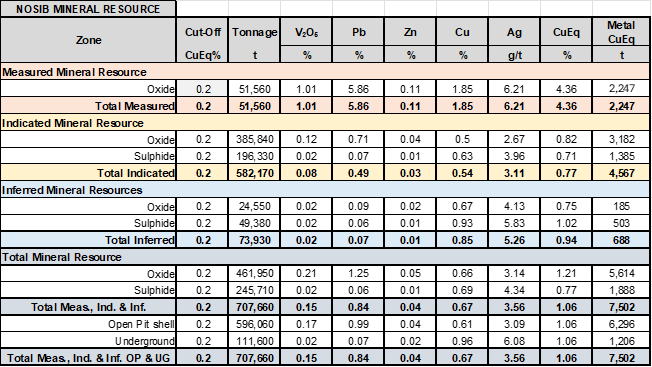
The Mineral Resource estimates for copper (Cu), lead (Pb), vanadium (V2O5), zinc (Zn) and silver (Ag) were performed in accordance with The Australasian Code for Reporting of Exploration Results, Mineral Resources and Ore Reserves (JORC, 2012). Shango verified and prepared the Golden Deeps database for 3-d modelling and Mineral Resource estimation by means of applying industry best practices.
The drill-defined Nosib deposit includes stratiform sulphide copper-silver mineralisation hosted by the Nosib Group arenites and diamictite/conglomerate, which underlies the carbonate units of the Tsumeb and Abenab sub-groups and hosts the majority of the mineral deposits in the Otavi region.
Overprinting the sulphide deposit is a supergene-oxide zone of vanadium-copper-lead-zinc-mineralisation which represents the majority of the Mineral Resources estimated from surface to approximately 80m vertical depth.
The open-pit Mineral Resource estimates were generated via an optimised pit shell (60-degree slope) and declared on the basis of reasonable prospects of eventual economic extraction.
In addition to the open pit Mineral Resources, underground Mineral Resources have also been declared, which are open to the west and at depth and represent a stratiform Cu-Ag sulphide target for further drilling, targeting underground Mineral Resources sufficient to support an underground development (Figures 4 & 5).
The maiden Mineral Resource model for the Nosib deposit will be combined with the updated Mineral Resource model and mining studies on the Abenab high-grade vanadium (Zn, Pb) deposit, to produce an integrated mining and processing Scoping Study for the production of vanadium with copper, lead, zinc and silver and potentially other valuable by-products such as molybdenum, germanium, gallium and HREEs. The results of the Scoping Study will be reviewed before further exploration to increase available Mineral Resources is considered and/or the study is upgraded to a PFS following further metallurgical testwork.
Khusib Springs Project
Khusib Springs Copper-Silver-Zinc Deposit
The Nosib prospect is located at the western end of the Company’s EPL3543 (Figure 1), 20km southwest
The Khusib Springs Mine was a high-grade mine located in the Otavi Mountain Land near Grootfontein in Northern Namibia (Figure 1). The deposit was discovered early in the 1990s through mapping and drilling and went into production in 1995. The deposit is a steeply plunging pipe-like lens hosted by limestone and is considered to be analogous with the Tsumeb Mine 40km to the northwest. Approximately 300,000t at 10% Cu, 584g/t Ag and 1.8% Pb was mined from the deposit. Khusib Springs has a similar geological setting to Tsumeb.
A Mineral Resource model is also being prepared for the Khusib Springs high-grade copper-silver deposit. The Company’s diamond drilling programs below an interpreted off-settign fault identified wide zones of copper-silver mineralisation below the previously mined zone. Results included a 90m copper-silver intersection grading 0.8% CuEq* (0.3% Cu, 52.3 g/t Ag, 0.06% Zn, 34.4 g/t Sb) from 389m downhole in KHDD006, including 28m @ 1.5% CuEq* (0.5% Cu, 101 g/t Ag, 0.1% Zn, 80.8 g/t Sb) from 402m (see Figure 6).
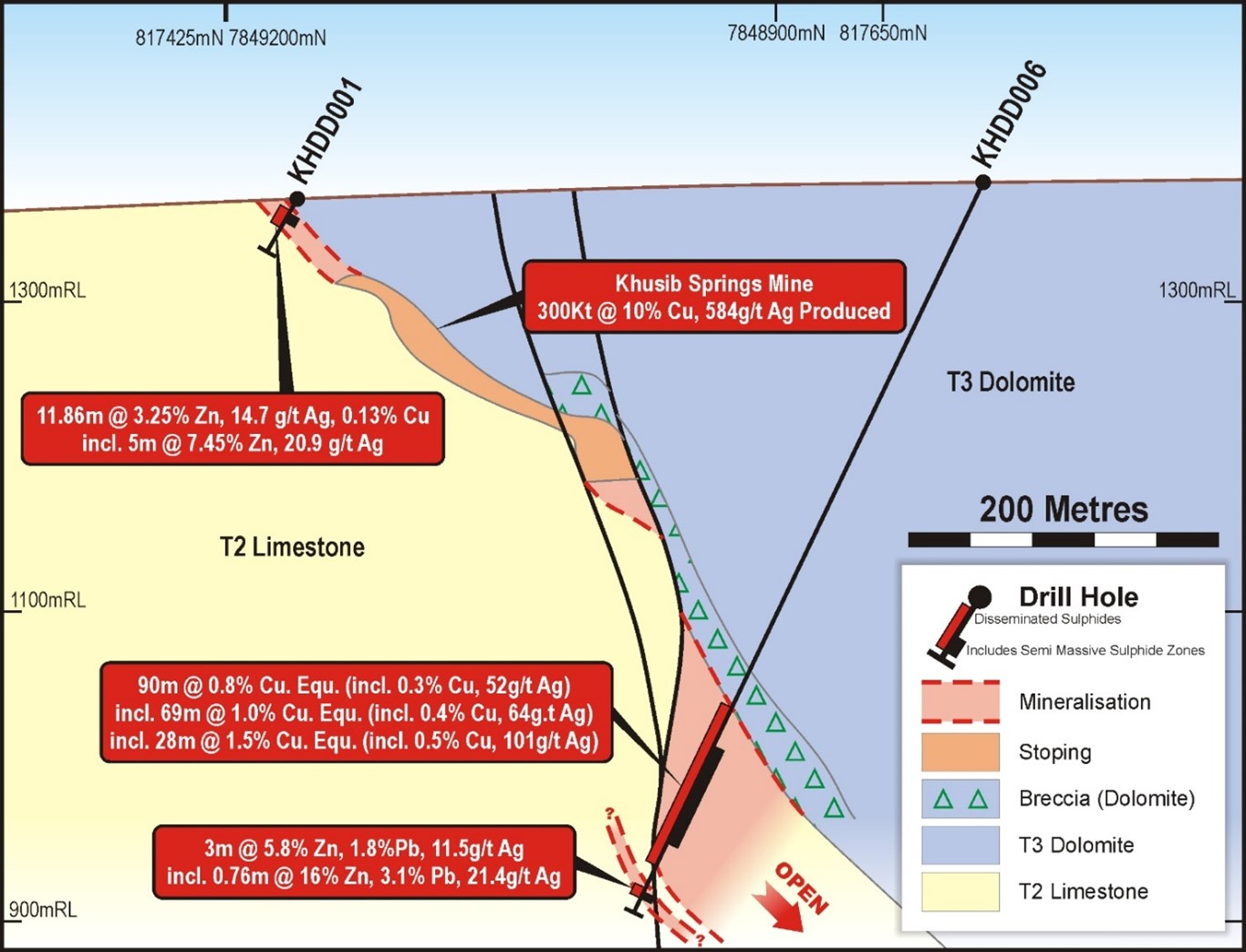
Shango are currently modelling this thick mineralised zone to determine Mineral Resource potential and identify targets for further drilling.

